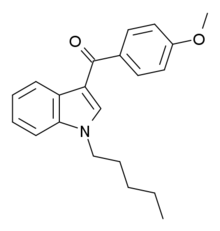

 | |
| Legal status | |
|---|---|
| Legal status |
|
| Identifiers | |
| |
| CAS Number | |
| ChemSpider |
|
| UNII | |
| CompTox Dashboard (EPA) | |
| ECHA InfoCard | 100.233.383 |
| Chemical and physical data | |
| Formula | C21H23NO2 |
| Molar mass | 321.420 g·mol−1 |
| 3D model (JSmol) | |
| |
| |
| | |
RCS-4, or 1-pentyl-3-(4-methoxybenzoyl)indole, is a synthetic cannabinoid drug sold under the names SR-19, BTM-4, or Eric-4 (later shortened to E-4), but originally, OBT-199.
RCS-4 is a potent cannabinoid receptor agonist, with EC50 values of 146 nM for human CB1 receptors, and 46 nM for human CB2 receptors.[2] All methoxyphenyl regioisomers, and N-butyl homologues of RCS-4 and its regioisomers also display potent agonist activities at CB1 and CB2 receptors.[2]
RCS-4 was banned in Sweden on 1 October 2010 as a hazardous good harmful to health, after being identified as an ingredient in "herbal" synthetic cannabis products.[3][4]
It was outlawed in Denmark on 11 March 2011.[5]
In August 2011, New Zealand added not only RCS-4 but also its 1-butyl homologue, and the 2-methoxybenzoyl isomers of both these compounds, to a temporary class drug schedule (i.e. equivalent to Class C but reviewed after 12 months, and with personal possession and use of small amounts decriminalised), which was newly created under the Misuse of Drugs Amendment Act 2011 passed a week earlier.[6][7][8]
As of October 2015 RCS-4 is a controlled substance in China.[9]
